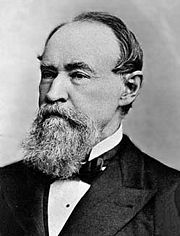
William Ferrel
Encyclopedia

United States
The United States of America is a federal constitutional republic comprising fifty states and a federal district...
meteorologist, developed theories which explained the mid-latitude atmospheric circulation
Atmospheric circulation
Atmospheric circulation is the large-scale movement of air, and the means by which thermal energy is distributed on the surface of the Earth....
cell in detail, and it is after him that the Ferrel cell is named. He was born in southern Pennsylvania. His family moved to what would become West Virginia in 1829. His formal elementary schooling was limited and he taught himself using science books well enough to become a school teacher. Despite financial difficulties, he was able to graduate from Bethany College's first graduating class in 1844. He would continue teaching in Missouri and Tennessee until 1858. At that point, he took up a full-time position on the staff of The American Ephemeris and Nautical Almanac in Cambridge, Massachusetts. In 1882, Ferrel joined the U.S. Army Signal Service (which would become the Weather Bureau in 1891). He retired in 1887. He died in West Virginia in 1891.
Ferrel demonstrated that it is the tendency of rising warm air, as it rotates due to the Coriolis effect
Coriolis effect
In physics, the Coriolis effect is a deflection of moving objects when they are viewed in a rotating reference frame. In a reference frame with clockwise rotation, the deflection is to the left of the motion of the object; in one with counter-clockwise rotation, the deflection is to the right...
, to pull in air from more southerly, warmer regions and transport it poleward. It is this rotation which creates the complex curvatures in the frontal systems
Weather front
A weather front is a boundary separating two masses of air of different densities, and is the principal cause of meteorological phenomena. In surface weather analyses, fronts are depicted using various colored lines and symbols, depending on the type of front...
separating the cooler Arctic air to the north from the warmer continental tropical air to the south.
Ferrel improved upon Hadley
George Hadley
George Hadley was an English lawyer and amateur meteorologist who proposed the atmospheric mechanism by which the Trade Winds are sustained. As a key factor in ensuring that European sailing vessels reached North American shores, understanding the Trade Winds was becoming a matter of great...
's theory by recognizing an until then overlooked mechanism. This is a quote from his first paper:
The fourth and last force arises from the combination of a relative east or west motion of the atmosphere with the rotatory motion of the earth. In consequence of the atmosphere's revolving on a common axis with that of the earth, each particle is impressed with a centrifugal force, which, being resolved into a vertical and a horizontal force, the latter causes it to assume a spheroidal form conforming to the figure of the earth. But, if the rotatory motion of any part of the atmosphere is greater than that of the surface of the earth, or, in other words, if any part of the atmosphere has a relative eastern motion with regard to the earth's surface, this force is increased, and if it has a relative western motion, it is diminished, and this difference gives rise to a disturbing force which prevents the atmosphere being in a state of equilibrium, with a figure conforming to that of the earth's surface, but causes an accumulation of the atmosphere at certain latitudes and a depression at others, and the consequent difference in the pressure of the atmosphere at these latitudes very materially influences its motions.
Hadley
George Hadley
George Hadley was an English lawyer and amateur meteorologist who proposed the atmospheric mechanism by which the Trade Winds are sustained. As a key factor in ensuring that European sailing vessels reached North American shores, understanding the Trade Winds was becoming a matter of great...
's erroneous reasoning had been in terms of a tendency to conserve linear momentum, as air mass travels from north to south or from south to north. Ferrel recognized that in meteorology and oceanography what needs to be taken into account is a tendency of an air mass that is in motion relative to the earth to conserve the angular momentum (of its angular velocity with respect to the Earth's axis).
External links
- NOAA biographical info
- MacTutor biography
- William Ferrel set bar for hurricane predictions (Times & Transcript, Moncton NB, Canada, 24 August 2009)

